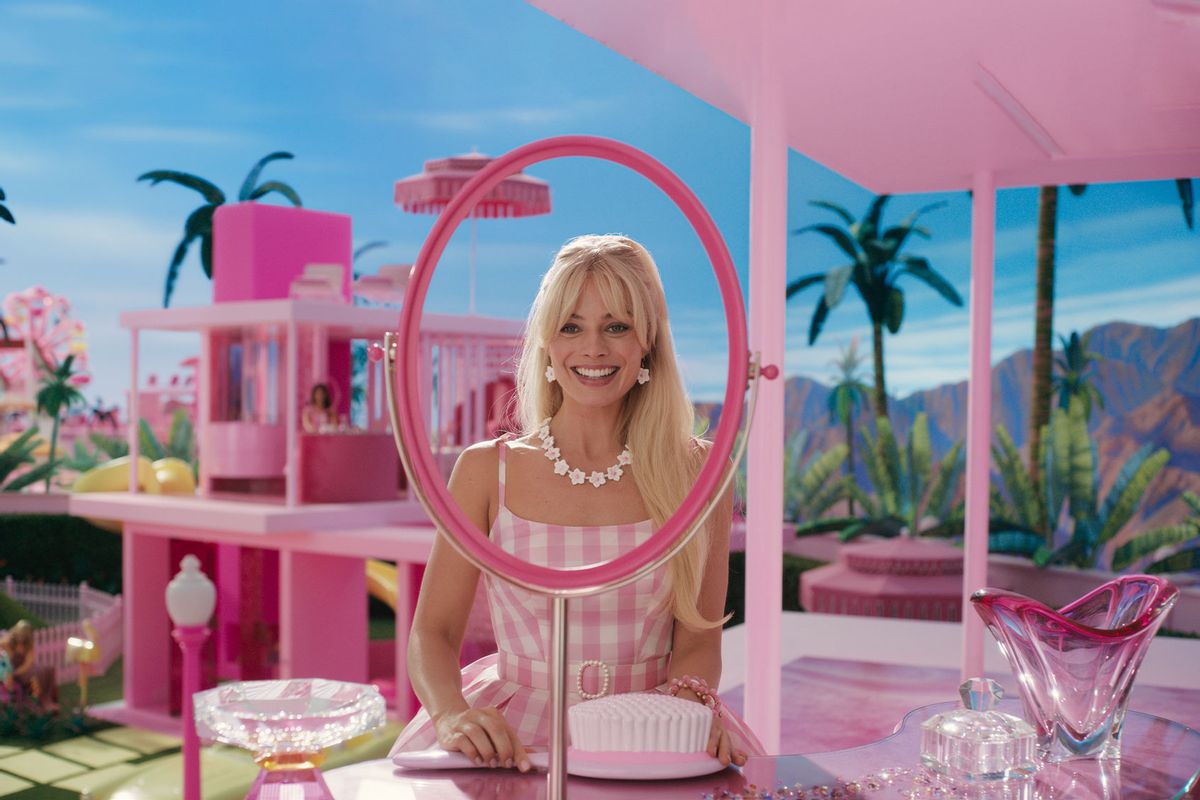My three-year-old daughter screamed "Barbie"! at the top of her little lungs, because somehow the film Margot Robbie stars in, directed by Greta Gerwig, made its way into her tiny toddler orbit.
"A Barbie movie?" I said, picking my baby up. "That sounds so cute; we can pop out one of your little pink dresses and pull up."
"I can't wait," my Aunt Robin said, "I'll be pulling out my pink dress too."
"Daddy can't have a dress. You a boy," my daughter giggled. At this tender age, she's very into specific ideas about gender. The girl will only wear dresses. We were in my office building a week ago, and she had to use the potty. I wasn't about to make the news as the big Black guy hanging in the women's bathroom on a college campus, so I tried to take her into the men's, and she lost it, pointing at the sign that read "MEN" next to the icon used to identify man on the door. Luckily, I was quick enough to bribe her with ice cream, before we swooped in and out.
I vividly remember my older sister and cousin, born in the late '70s, having white Barbie dolls.
The "Barbie" movie was a month or so out, and it didn't really cross my mind until I found out Issa Rae would be in the flick. I've been an Issa Rae fan since the "Awkward Black Girl" web series days; as a matter of fact, I may have watched HBO's "Insecure" more times than her, so I was beyond excited. Some personal nostalgia even kicked in for me.
I vividly remember my older sister and cousin, born in the late '70s, having white Barbie dolls. Having a Barbie was a big deal – we were living in the trenches, and toys were a luxury. Imagine living in a primarily Black neighborhood and being gifted a tall white, blonde doll with multiple outfits and career choices. Barbie could have been anything she wanted, from a supermodel to a doctor. My sister owned that, and maybe that ambition rubbed off on her. I still bit the heads off as I liked to bite the heads off of all her dolls. I also remember when my little cousin Tia, born in the '80s like me, tore off the plastic wrap of a Black Barbie, and the sense of pride we all felt, knowing we all could be a part of the Barbie world too. Black Barbie looked like my sister, mom or aunt. It was amazing. I bit the head off of that Black Barbie too, as I was an equal-opportunity terrorist.
Tia's Black Barbie made it to us in the '90s; however, the first Black Barbie was inspired by Diana Ross and introduced into the world back in 1980. It was designed by Louvenia "Kitty" Black Perkins and came in a box that read, "She's black! She's beautiful! She's dynamite!"
It's wild that the first Barbie doll dropped in 1959, and even though Black people were everywhere, we didn't get a Black version until two decades later. But this is 2023, and the movie should be way more progressive than the company's history, right? Wrong. I watched the trailer and was overwhelmed with whiteness.
I never heard a white person say, "The representation was poor; I just don't see myself in the art."
Barbie, which does have a few nonwhite cast members, including Rae, America Ferrera, and Ncuti Gatwa, has one of the whitest trailers I ever saw in my life. And no, I'm not that guy; I genuinely believe that artists and filmmakers can create whatever they want, but I must be cautious of what I expose my daughter to. She's too young to understand the complexities of gender, so how do you even begin to open the door to conversations about race and how movies and commercials in America act like white people have a monopoly on beauty? Google "attractive woman" and watch the page fill up with white faces.
As a family, we must be intentional when we buy Black dolls, books with Black queens and princesses and allow her to watch cartoons like "Gracie's Corner," "OmoBerry" and "Karma's World." And no, we are not teaching her to only connect with Black art; it's just that everything white is always available and at the forefront of everything. You don't have to search for white content; it's already in your face.
I never heard a white person say, "The representation was poor; I just don't see myself in the art," yet Black people and people of color deal with this daily. America intentionally and unintentionally shoves whiteness down our throats every day, every minute, every second, and there's not much we can do about it, other than thoughtfully curating a child's experience.
Dr. Kenneth Clark and Dr. Mamie Clark created the legendary doll test in the 1940s, asking Black children if they would prefer playing with a white or a Black doll. Most of the Black children chose white dolls because they were perceived as more friendly and beautiful. The Clarks' findings led to them being expert witnesses in Briggs v. Elliott (1954), one of the five cases attached to Brown v. the Board of Education. What's scarier is that about 60 years have passed, and Dr. Toni Sturdivant, an assistant professor at Texas A&M, conducted the same tests in 2021 and got nearly the same results. Black dolls weren't good enough for Black children.
The fact is, I can do everything in my power to keep my daughter away from the "white is always right" ideology and still may not be able to protect her from that way of thinking because our country is so fixed on that message. But that doesn't exempt me from religiously teaching her that Black is beautiful, even though Hollywood is only willing to show it in small doses.
Avoiding films like "Barbie" is a part of that teaching.



Shares